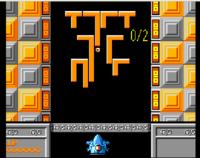Quarth
| Quarth | |
|---|---|
 Arcade flyer for Quarth. | |
| Developer(s) | Konami |
| Publisher(s) | Konami and subsidiaries (Ultra Games in US) |
| Composer(s) | Norio Hanzawa |
| Platform(s) | Arcade, MSX2, NEC PC-9801, Sharp X68000, Famicom, Game Boy, Mobile phone, Virtual Console |
| Release date(s) | Arcade Q4 1989 Game Boy JP March 16, 1990 NA 1990 MSX2 1990 Famicom JP April 13, 1990 i-mode phones EU 2005 Wii Virtual Console (MSX Version) JP February 2, 2010 3DS Virtual Console (Game Boy Version) JP February 22, 2012 NA September 27, 2012 |
| Genre(s) | Puzzle game/Shoot 'em up |
| Distribution | ROM cartridge |
Quarth (クオース) is a hybrid puzzle game/shoot 'em up developed by Konami which was released in 1989 as an arcade game, sold as Block Hole outside Japan.
Besides the arcade version, there were also ports of the game to the MSX2 (with a built-in SCC chip), Famicom, and Game Boy—home releases used the Quarth name worldwide (with the exception of the Game Boy Color release in Europe of Konami GB Collection Vol. 2, where the game was renamed to the generic title Block Game for unknown reasons).
Quarth was released on the Konami Net i-mode service as Block Quarth, with an updated Block Quarth DX in 2001. It was released without the "DX" suffix in 2005, and was made globally available through Konami Net licensing on many i-mode services offered by mobile operators. In Europe, for example, it was available from O2 UK, O2 Ireland, and Telefónica Spain.
In 2005, Konami also included the game in the Nintendo DS title Ganbare Goemon: Tōkai Dōchū Ōedo Tengu ri Kaeshi no Maki. An emulated version of the game was released in 2006 for PlayStation 2 in Japan as part of the Oretachi Geasen Zoku Sono-series.
Gameplay

Quarth is a combination of Tetris-style gameplay and a fixed shooter in the Space Invaders tradition. The player's focus is on falling blocks, and the action is geometrical. Rather than arranging the blocks together to make a row of disappearing blocks, a spaceship positioned at the bottom of the screen shoots blocks upwards to make the falling block pattern into squares or rectangles. Once the blocks have been arranged properly, the shape is destroyed and the player is awarded points based on the shape's size. The blocks continue to drop from the top of the screen in various incomplete shapes. As each level progresses, the blocks drop at greater speed and frequency. There are also various power-ups which could be located to increase your ship's speed, among other bonuses.
The game continues until the blocks reach the dotted line at the bottom of the screen, whereupon the player's ship is "quarthed," crushed flat.
Multi-player
Like most arcade games, the game featured a multi-player mode. In the arcade, this was demonstrated via a split screen with Player 1 on the left and Player 2 on the right. For the Game Boy, multiplayer required the Game Boy Link Cable with each player able to view only their fields on their own Game Boys.
The MSX2 and Famicom versions had two different 2-player modes: Mode A, where both players worked together on the same game, and Mode B which was the same as the arcade split-screen game.